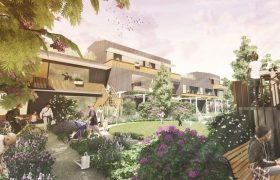Perceptions around density are changing. The family profile is evolving. We have an aging population. Kids are living at home longer. The traditional housing model of South East Queensland is not going to cut it anymore, and a more diverse, targeted housing offer is needed.
With this in mind, the Density and Diversity Done Well competition sought ideas for new housing options for Queensland.
The competition asked for submissions to explore potential outcomes for the ‘missing middle’ – dwellings which fall somewhere in between the traditional three-bedroom suburban house and high-rise apartments.
While Queensland has traditionally steered away from this style of housing, it’s increasingly clear that a typical neighbourhood block or high-rise won’t suffice for the future. Particularly within the ‘inner-ring’ of our cities, where centres, public transport and amenity are within reach.
At Urbis, we were thrilled to pool our Design, Planning, Research, Policy and Economics expertise to contribute to the competition. Urbis submitted three entries, and we’re proud to see all our submissions receiving commendations or mentions (out of 100 entries competition-wide).

